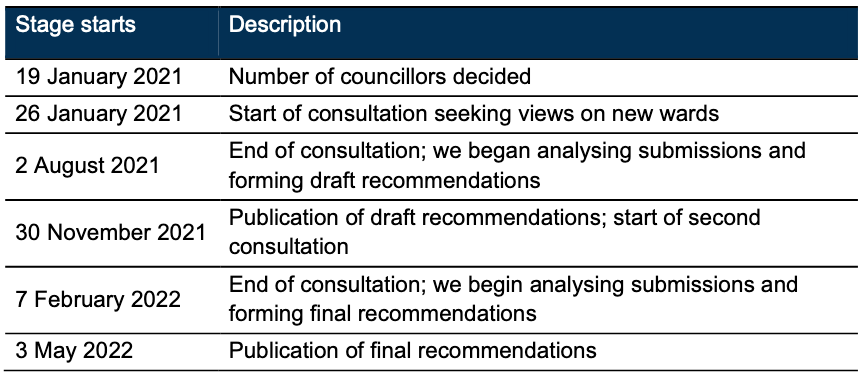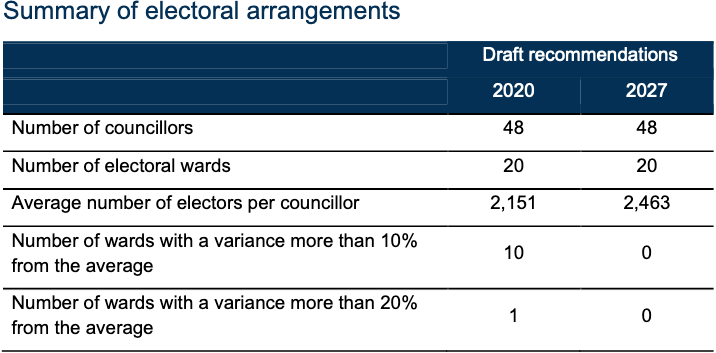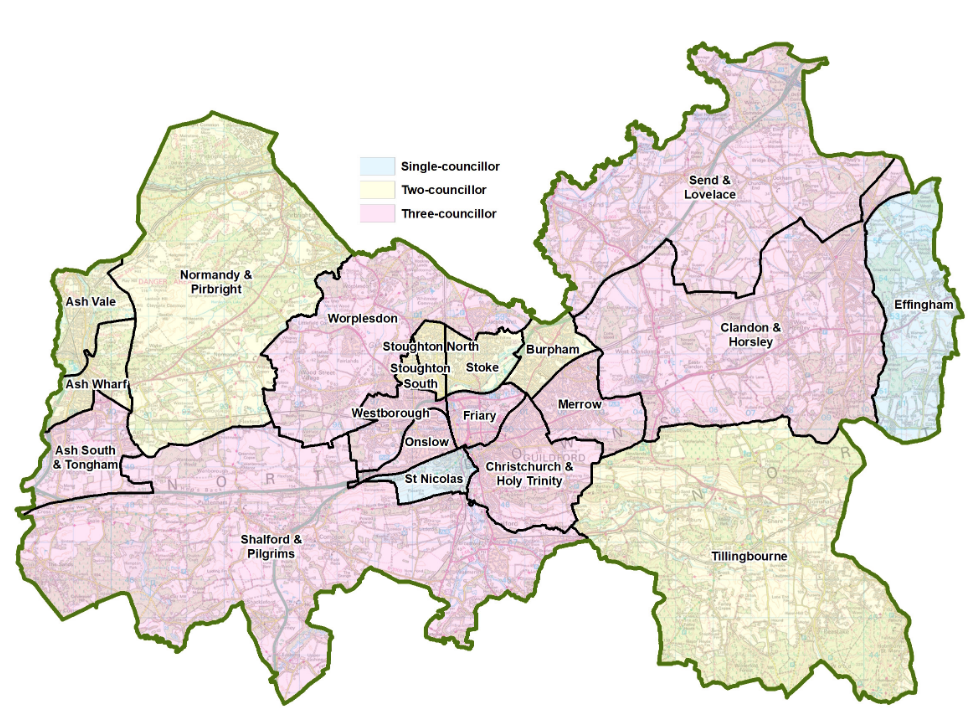 Abraham Lincoln
If given the truth, the people can be depended upon to meet any national crisis...
Abraham Lincoln
If given the truth, the people can be depended upon to meet any national crisis...
 Guildford news...
for Guildford people, brought to you by Guildford reporters - Guildford's own news service
Guildford news...
for Guildford people, brought to you by Guildford reporters - Guildford's own news service
Most Guildford Council Ward Boundaries to Change if Recommendations Are Accepted
Published on: 5 Dec, 2021
Updated on: 5 Dec, 2021
Local voters and organisations are being asked to comment on draft recommendations for new ward boundaries across Guildford Borough.
If Local Government Boundary Commission recommendations, the result of a review, are accepted, boundaries of 19 wards should change; three will stay the same; and the number of wards would reduce by two from 22 to 20.
But the Commission says: “We have an open mind about further suggestions from local people to change and improve these recommendations.
“We will consider all the submissions we receive whoever they are from and whether your evidence applies to the whole of Guildford or just a part of the area.”
The Commission is accountable to Parliament but is not part of the government or any political party. Its stated aim for this required periodic review is to propose a pattern of wards for Guildford Borough Council which delivers:
• Electoral equality: each councillor represents a similar number of electors.
• Community identity: reflects the identity and interests of local communities.
• Effective and convenient local government: helping your council discharge its
responsibilities effectively.
The last review was held in 1998. The size of the electorate across the whole borough is expected to grow 14.5% between 2020 and 2027.
Under the current recommendations:
The overall number of borough councillors would remain at 48. There would be 10 three-councillor wards, eight two-councillor and two single-councillor wards across the council area. Most wards would see their boundaries change to some degree.
Pirbright and Normandy wards, currently with one councillor each, would merge and be represented by two councillors.
Shalford and Pilgrims wards, currently with two councillors and one councillor respectively, would merge and be represented by three councillors
Send and Lovelace wards, currently with two councillors and one councillor respectively, would merge and be represented by three councillors.
Friary & St Nicolas ward, currently represented by three councillors, would divide into two: Friary ward represented by three councillors and St Nicolas by one.
Holy Trinity and Christchurch wards, currently with three councillors and two councillors respectively, would merge and be represented by three councillors.
As part of the review, the Commission received submissions from Guildford Borough Council, Mole Valley Conservative Association, The Peace Party, GBC councillors Dennis Booth (R4GV) and George Potter (Lib Dem), 23 local residents, and local organisations:
- Boxgrove Park Residents’ Association Committee
- Burpham Neighbourhood Forum (two submissions)
- Merrow Residents’ Association
- The Royal Horticultural Society
The following Parish Councils also made submissions: East Horsley; Effingham; Pirbright; Ripley; Seale & Sands; Send Parish; Shere; West Clandon; and West Horsley.

Review timetable. It is expected that the changes would become effective before the next borough election in 2023.
Cllr Tony Rooth (R4GV, Pilgrims) who was the chair of the cross-party working group which prepared the council’s submission to the Commission, commented: “The draft recommendations reflect most of the Council’s proposals within its submission, with a small number of fairly minor differences within some of the town wards.”
A cross-party working group of councillors will be considering the draft recommendations over the next few weeks and will draw up a draft response for consideration by the full Council in February.
The council urges residents to have their say on the draft recommendations, by going on to the LGBCE’s website to respond: https://consultation.lgbce.org.uk/have-your-say/24724
 Catherine Houston, chair of Guildford Liberal Democrats, said: “Overall we welcome the proposals. The changes they have made to Guildford Borough Council’s initial submissions are largely reasonable, align well with natural communities, and make a good starting point for discussion.
Catherine Houston, chair of Guildford Liberal Democrats, said: “Overall we welcome the proposals. The changes they have made to Guildford Borough Council’s initial submissions are largely reasonable, align well with natural communities, and make a good starting point for discussion.
“We encourage everyone in Guildford borough to respond to the consultation with their thoughts on the proposed boundaries. These consultations normally attract very low numbers of responses, so individual voices can make a significant impact. Given these boundaries will likely be in place for the next decade at least, it’s very important that any anomalies are flagged up now in this final consultation.
“We do, however, have one particular area of concern. Under the boundary commission’s proposals the Ash and Tongham area will be 23% above quota, leaving the area significantly under-represented.
“Given the high levels of housebuilding in the area, and the fact that local government boundaries often go a very long time without review (Guildford’s last review was in 1998), we are worried that local residents in our borough’s second urban area could soon find their votes electing a far smaller voice in the council chamber than they should be entitled to.
“We will be raising this concern with the commission.”
Sallie Barker, chair of the Guildford Conservative Association, said: “We are aware of the boundary proposals. We will be listening to our members and residents and will respond to the consultation in due course.”
Mark Bray-Parry of the Green Party said: “With housing developments due to change the distribution of voters throughout the Borough with an extra 15,000 electors expected by 2027, boundary changes are an essential tool to ensure democracy remains balanced.
“Ultimately, these proposals achieve that, as can be seen by the reduction in the ward electoral variance, with no wards having a 10% variance compared to 10 wards with current boundaries.
“The increasing number of electors brings the average electors per councillor towards 2,500. While I would not like to see this increase further, I believe maintaining the same number of Councillors is the right decision as increasing the total Councillors while maintaining a low elector variance would be extremely challenging.
“I am also pleased that both the council and the boundary commission appear to have put significant effort into ensuring local communities are not divided by both new and existing ward boundaries.
“For these reasons, I am supportive of the recommendations.”
The proposed changes could significantly affect the political balance of the borough council in future elections. The next is due in May 2023.
It is interesting that the Lib Dems are pointing out the under-representation of the staunchly Conservative, so-far at least, Ash Wards. Perhaps the Lib Dems are hopeful of future success there?
R4GV councillor Tony Rooth appears sanguine about the changes but his party could lose out if their five town centre seats are reduced to three under the merger of Holy Trinity and Christchurch wards. They are also likely to be affected by the merger of Shalford and Pilgrims, where they currently have two of the three seats and in the east of the borough by the merger of Lovelace and Send.
Slow progress on the Local Plan review has caused R4GV’s popularity to wane in the eastern villages, perhaps to the future benefit of the Guildford Greenbelt Group. Currently, with the antipathy towards the Local Plan continuing, it is hard to see a Tory recovery in these normally safe Conservative wards.
But the multitude of smaller boundary changes could also affect the political balance within wards in ways impossible to predict. One thing seems certain. The 2023 election will be interesting.
Responses to Most Guildford Council Ward Boundaries to Change if Recommendations Are Accepted
Leave a Comment Cancel replyPlease see our comments policy. All comments are moderated and may take time to appear.
Recent Articles
- Guildford Institute’s Crowdfunding Project for Accessible Toilet in its New Community and Wellbeing Centre
- Letter: Guildford – Another Opportunity Missed?
- Letter: GBC’s Corporate Strategy – Where Is the Ambition?
- My Memories of John Mayall at a Ground-breaking Gig in Guildford Nearly Six Decades Ago
- Westborough HMO Plans ‘Losing the Heart of the Street’ Says Resident
- College Invests to Boost Surrey’s Economy and Close Digital Skills Gap
- Community Lottery Brings Big Wins for Local Charities
- GBC Housing Plan Promises ‘A Vibrant Urban Neighbourhood’ Near Town Centre
- Hospital Pillows ‘Shortage’ at the Royal Surrey
- Updated: Caravans Set Up Camp at Ash Manor School


Recent Comments
- Ian Macpherson on Updated: Main Guildford to Godalming Road Closed Until August 1
- Sara Tokunaga on GBC Housing Plan Promises ‘A Vibrant Urban Neighbourhood’ Near Town Centre
- Michael Courtnage on Daily Mail Online Reports Guildford Has Highest-paid Council Officer
- Alan Judge on GBC Housing Plan Promises ‘A Vibrant Urban Neighbourhood’ Near Town Centre
- John Perkins on GBC Housing Plan Promises ‘A Vibrant Urban Neighbourhood’ Near Town Centre
- S Collins on GBC Housing Plan Promises ‘A Vibrant Urban Neighbourhood’ Near Town Centre
Search in Site
Media Gallery
Dragon Interview: Local Artist Leaves Her Mark At One of England’s Most Historic Buildings
January 21, 2023 / No Comment / Read MoreDragon Interview: Lib Dem Planning Chair: ‘Current Policy Doesn’t Work for Local People’
January 19, 2023 / No Comment / Read MoreA3 Tunnel in Guildford ‘Necessary’ for New Homes, Says Guildford’s MP
January 10, 2023 / No Comment / Read More‘Madness’ for London Road Scheme to Go Ahead Against ‘Huge Opposition’, Says SCC Leader
January 6, 2023 / No Comment / Read MoreCouncillor’s Son Starts Campaign for More Consultation on North Street Plan
December 30, 2022 / No Comment / Read MoreCounty Council Climbs Down Over London Road Works – Further ‘Engagement’ Period Announced
December 14, 2022 / No Comment / Read MoreDragon Interview: GBC Reaction to the Government’s Expected Decision to Relax Housing Targets
December 7, 2022 / No Comment / Read MoreHow Can Our Town Centre Businesses Recover? Watch the Shop Front Debate
May 18, 2020 / No Comment / Read More

















John Phelps
December 5, 2021 at 4:47 pm
“Slow progress on the Local Plan review has caused R4GV’s popularity to wane in the eastern villages, perhaps to the future benefit of the Guildford Greenbelt Group.”
Where has this data come from? Has the editor done a poll that he has yet to share with his readers? More and more this paper seems to be turning into gossip clickbait.
Martin Elliott
December 5, 2021 at 5:52 pm
I suppose Slyfield Industrial Estate isn’t a community, but despite its development/extension, why is the northern part (Dennis Way) in Stoughton when the majority is in Stoke?
It would have seemed logical at any previous boundary review to have moved it.
Or is it a freehold issue? Or business rates?
Editor’s comment: the report states, “A local resident requested that the Slyfield Industrial Estate be fully
incorporated in Stoke ward. We could not adopt this proposal as it would result in the creation of a parish ward for Worplesdon parish with no electors, which would not provide for effective and convenient local government. The
local resident also suggested that the Jacobs Well area be included within a Burpham or Stoke ward. We decided not to adopt this proposal as it would result in unacceptably high forecast electoral variances of 26% and 20% for our proposed
Burpham and Stoke wards, respectively.
John Perkins
December 6, 2021 at 5:03 pm
The increase in the number of electors used to define the boundary changes appear to be similar to the amount of new housing in the Local Plan.
John Perkins
December 7, 2021 at 6:35 pm
Multi-member wards were recognised as being undemocratic in the 19th century.
The proposed boundary changes will increase the problem and make it more difficult for independent representatives or smaller parties to gain seats on the council.
My own ward, Lovelace, which returned an R4GV councillor by a huge majority, and Send, which returned two GGG councillors by large majorities, would quite possibly end up with one Conservative councillor for no better reason than that the Tories are able to field three candidates.
Only the bigger, richer, parties benefit from a reduced number of wards.